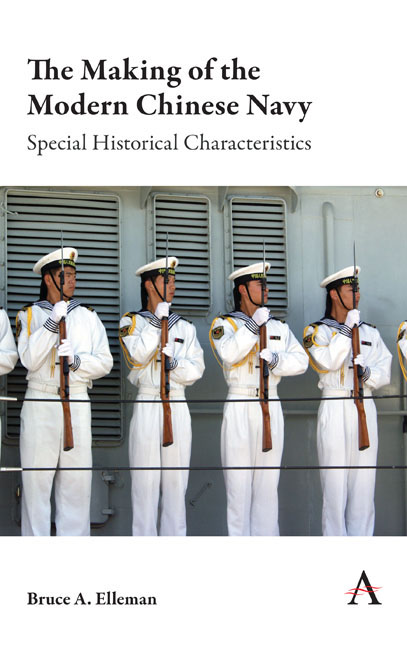Book contents
- Frontmatter
- Contents
- Introduction: The Special Characteristics of China's Maritime History
- 1 Battle of Bạch Đăng River (938)
- 2 Battle of Yaishan (1279)
- 3 Battle of Lake Poyang (1363)
- 4 Ming–Kotte War in Southeast Asia (1410–11)
- 5 Ming Loyalists Flee to Taiwan (1661–83)
- 6 Battle of Chuanbi (1839)
- 7 Sino-French War (1884–85)
- 8 Qing Beiyang Fleet's Defeat in the Battle of the Yellow Sea (1894)
- 9 Chinese Decision to Sink The Nationalist Navy as Blockships (1937)
- 10 Chongqing Mutiny Allowing the PLA to Cross the Yangzi River (1949)
- 11 The Taiwan Strait Crises (1954–55 and 1958)
- 12 China's Decision to Take the Paracel Islands from South Vietnam (1974)
- 13 Missile Blockade: The Taiwan Strait Crisis (1995–96)
- 14 The EP-3 Standoff and Diplomatic Resolution (2001)
- Conclusions: The Influence of History on the Formation of a Modern Chinese Navy
- Selected Bibliography
- Index
9 - Chinese Decision to Sink The Nationalist Navy as Blockships (1937)
Published online by Cambridge University Press: 04 October 2019
- Frontmatter
- Contents
- Introduction: The Special Characteristics of China's Maritime History
- 1 Battle of Bạch Đăng River (938)
- 2 Battle of Yaishan (1279)
- 3 Battle of Lake Poyang (1363)
- 4 Ming–Kotte War in Southeast Asia (1410–11)
- 5 Ming Loyalists Flee to Taiwan (1661–83)
- 6 Battle of Chuanbi (1839)
- 7 Sino-French War (1884–85)
- 8 Qing Beiyang Fleet's Defeat in the Battle of the Yellow Sea (1894)
- 9 Chinese Decision to Sink The Nationalist Navy as Blockships (1937)
- 10 Chongqing Mutiny Allowing the PLA to Cross the Yangzi River (1949)
- 11 The Taiwan Strait Crises (1954–55 and 1958)
- 12 China's Decision to Take the Paracel Islands from South Vietnam (1974)
- 13 Missile Blockade: The Taiwan Strait Crisis (1995–96)
- 14 The EP-3 Standoff and Diplomatic Resolution (2001)
- Conclusions: The Influence of History on the Formation of a Modern Chinese Navy
- Selected Bibliography
- Index
Summary
Destruction of valuable naval equipment appeared during the second Sino-Japanese War (1937–45). While during its first war with Japan, Chinese naval officers sought to conserve their equipment, in the second war it was perhaps wasted needlessly. Specifically, during the second Sino-Japanese War the bulk of the Nationalist navy was sunk as blockships in what soon became clear was a useless effort to slow the Japanese advance up the Yangzi River. Competing Chinese fleets even matched each other to sink more ships. In the end, scuttling the Nationalist navy did not stop the Japanese. Since many of the sunken ships were in shallow waters, they could be salvaged and used by the Japanese invaders. For example, Ninghai and Pinghai were successfully refloated, adopted into the Japanese Imperial Navy, and renamed Mikura and Mishima.
Summary of the Nationalist Blockship Strategy
A blockship is a vessel deliberately sunk to prevent the use of a river, canal, or harbor. It may either be sunk by a navy defending the waterway to prevent the ingress of attacking enemy forces, or it may be brought by enemy raiders and used to prevent the waterway from being transited by the defending forces. This practice goes back many centuries. In China, it was a long-time tactic of the Chinese navy to block any maritime threat to China's internal rivers and canals by clogging harbors with log booms and chains strung from a row of floating junks. A famous battle scene in the 1966 Hollywood blockbuster Sand Pebbles takes place over destroying just such a river obstacle.
In 1930, Chiang Kai-shek appointed Admiral Ch'en Shao-kuan (1889–1969) the acting Minister of the Navy, and in 1932 he became the full Minister. Ch'en adopted an ambitious naval program, which envisioned 71 first-line ships, including battleships, cruisers, destroyers, submarines, and carriers, plus a total of 34 support ships, including submarines, depot ships, mine sweepers, torpedo boats, and hospital ships. The formation of this new force was to be divided into a Central, Northeast, and Guangdong Navy, with the Central navy being the largest and composed of two regular squadrons and a training squadron, the Northeast Navy accounting for the second fleet, and the Guangdong navy accounting for the third.
- Type
- Chapter
- Information
- The Making of the Modern Chinese NavySpecial Historical Characteristics, pp. 43 - 46Publisher: Anthem PressPrint publication year: 2019



